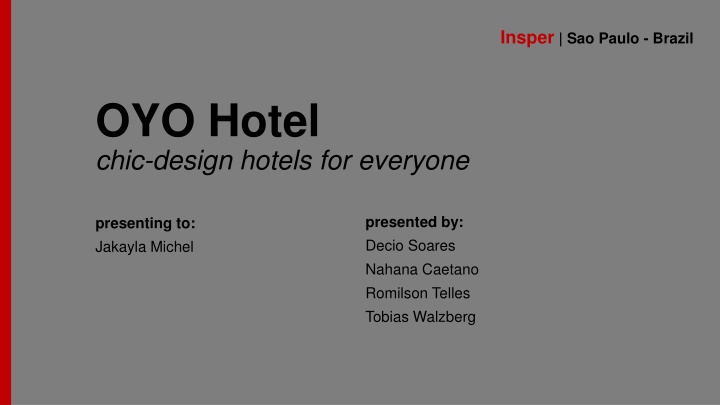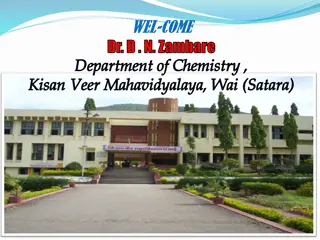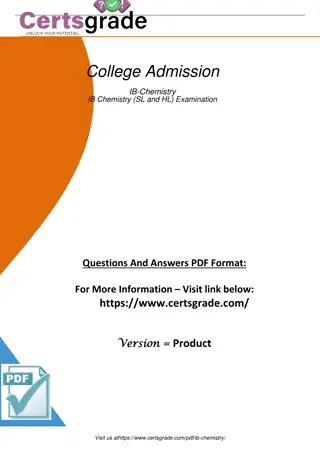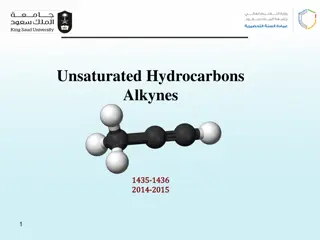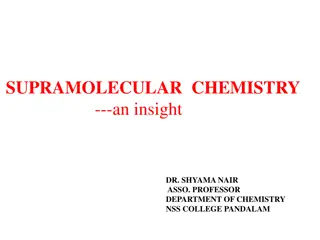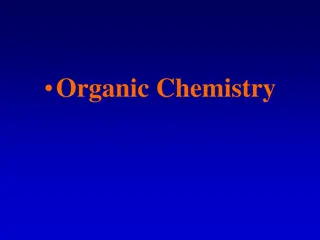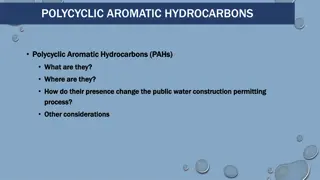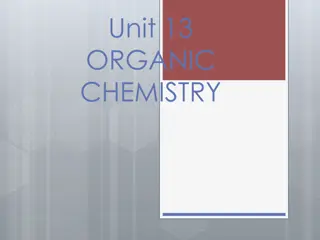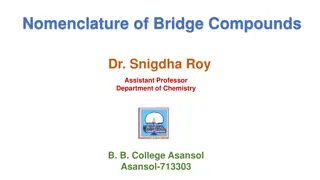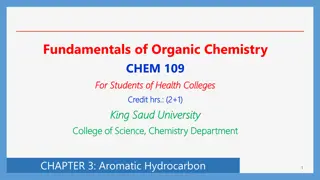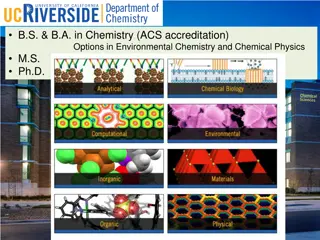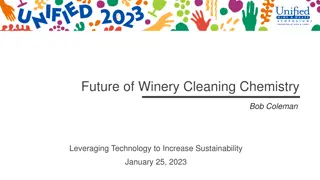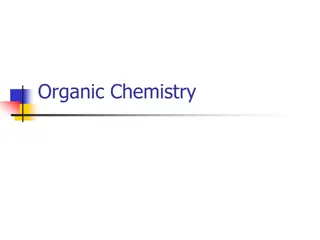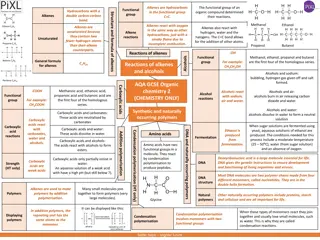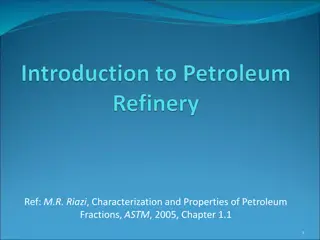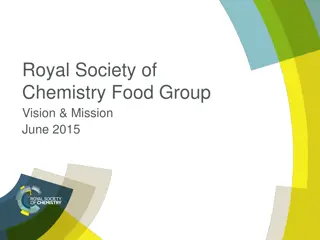Chemistry of Hydrocarbons
Hydrocarbons are organic compounds composed of hydrogen and carbon atoms, with petroleum being a crucial source. Fossil fuels like crude oil, coal, and natural gas are products of ancient organic matter. Petroleum, a primary hydrocarbon source, is refined to produce gasoline, lubricants, and various consumer goods. Discover the molecular formulas, uses, efficiency, and activities related to hydrocarbons in the energy sector.
Download Presentation

Please find below an Image/Link to download the presentation.
The content on the website is provided AS IS for your information and personal use only. It may not be sold, licensed, or shared on other websites without obtaining consent from the author.If you encounter any issues during the download, it is possible that the publisher has removed the file from their server.
You are allowed to download the files provided on this website for personal or commercial use, subject to the condition that they are used lawfully. All files are the property of their respective owners.
The content on the website is provided AS IS for your information and personal use only. It may not be sold, licensed, or shared on other websites without obtaining consent from the author.
E N D
Presentation Transcript
Insper | Sao Paulo - Brazil OYO Hotel chic-design hotels for everyone presented by: Decio Soares Nahana Caetano Romilson Telles Tobias Walzberg presenting to: Jakayla Michel
agenda 1 | introduction 2 | analysis of the situation 3 | alternatives 4 | recommendations 5 | implementation 6 | wrap-up
There are two big things I learned. The first was to be able to do innovative things. The second was that if you are thinking anyway, think big. Mr. Ritesh Agarwal, founder of OYO Hotels
business dilemma 1. Did OYO strategy make sense? 2. OYO past challenges/ how to overcome? 3. Future prospects? 4. Business model sustainability? 5. Translation to the American market? 6. Should Michel apply for a job?
OYO design cool, in spaces wherever you need them, at fantastic prices Business model for hotels Profitabilitythrough higher occupation(90%) Apps manage services, i.e. housekeeping Franchises to hotels Pays $ 2k upfront Guarantees 100% revenue for 10% commission 20% commission for additional revenue Founded by Ritesh Agarwal (Thiel fellowship) The largest hotel chains in the world emerging-market unicorn among unicorns Business model for users Raised $ 1.8 Bn Transparency Standardized quality 3-tap-to-buy app
analysis of the situation
OYOs business expansion International expansion (Malaysia, Nepal, China, Indonesia, UAE USA & Japan Oravel Stays became OYO $300 million to enter USA market 2012 2013 2016 2017 2018 2019 Venture Nursey funded Oravel Stays OYO becomes the largest network of budget hotels in India United Kingdom
Challenges 1 2 3 4 5 6 7 8 Lack of consistency Pricing conflicts Capital needs Brand trust Proprietary technology Change in business model From partnership to franchising Global expansion High initial costs Hotel upgrades Cleaning Room services Plumbling problems Conflict between OYO and 3rd party rooms Raise of funding Positive brand True partner Propietary app and princing algorithm Market differences
OYOs franchising model Technology 3 key ways Undermanaged real estate assets App & Branding
OYOs brand expansion OYO Townhouse OYO Home Collection O Capital O SilverKey Palette Resorts OYO Life
Current model growth by expansion as is Total room growth considers doubling every 2nd year (mkt share below) Occupation maintained at 90% Prices constant Operational costs are reduced yearly Net loss halved annually (based on previous trends) Similar to Amazon growth model Global Market Share (rooms %) 160MM rooms 2.5% 1.9% 1.3% 0.9% 0.6% 2018/19 2019/20 2020/21 2021/22 2022/23
Current model Net loss continues along time fast build up of costs Revenue vs. Cost ("as is") Approx. Breakeven $7,000 $6,000 $5,000 $4,000 $3,000 $2,000 $1,000 $- 2016/17 2017/18 2018/19 2019/20 2020/21 2021/22 2022/23 Revenue Cost
Low Capex expansion growing through investments in high class hotels Main perceived driver of net loss: up front Capex in lower class (budget) hotels The $2,000 investment needs an approx. turnover of 200 stays (RevPAR $50, commission of 20%) Total room growth considers doubling every 2nd year Occupation maintained at 90% Prices constant Operational costs constant Investment costs per additional room halved to $1,000 "as is" Alternative $ 1,000 $ 50 $ 10 Initial Daily 20% daily $ 2,000 $ 50 $ 10 Turnover needed (days) Yearly bookings to pay for investment 200 55% 100 27%
Revisited model lower implementation costs, constant revenue Revenue vs. Cost (alternative) $7,000 $6,000 $5,000 $4,000 Breakeven $3,000 $2,000 $1,000 $- 2016/17 2017/18 2018/19 2019/20 2020/21 2021/22 2022/23 Revenue Cost The model becomes sustainable with the reduction of upfront costs The funds already raised can be used to boost the investment model in the US gaining scale more rapidly if wanted
Revisiting the business model Expansion through the franchising of higher class hotels Franchising is a successful model Total RevPAR is boosted through high occupancy rates In order to revert losses, a reduction of upfront cost is strongly recommended In order to maintain overall quality with less expenditure, high class partners are needed Expansion should move from budget market to higher class markets Although the market appears to be more competitive consolidated brands could benefit from the platform through: higher occupancy rates (boosting RevPAR); and Cost reduction (tech use)
Ongoing expansion in the US and worldwide Financial repositioning -$ 1000/ new room Operational improvements Test new formats (i.e Hooters) App development Boost local mom and pop hotels Test supporting stablished hotel chains Expansion @ US Maintain current strategy Expansion @ India Expansion @ UK/ Japan Assess BU success Expansion @ new markets BRICs (India model) North America (US model)
Roll-out to the USA market Competition is a major challenge Total market: 71% controlled by branded hotels Economy market: 53% controlled by branded hotels Main competitors: Tru by Hilton Days Inns by Windham Holiday Inn Express Extended Stay America Choice Hotel
Roll-out to the USA market Strategy implementation 1. Transforming unbranded hotels into OYO consistent experience (transparency & standardization) 2. Focus on technology instead of branding 3. Increase in occupancy rate through AI in the pricing algorithm 4. Focus on millennial audience
Drivers for Ms Michel to accept the job Drivers Risk Observation Ethics Past problems with ethics issues Revised model Business growth and sustainability Real opportunity Unicorn Salary Competitive salary
1. Did OYO strategy make sense? 2. OYO current challenges/ how to overcome? 3. Future prospects? 4. Business model sustainability? 5. Translation to the American market? 6. Should Michel apply for a job? wrap-up
thank you merci beaucoup obrigado
